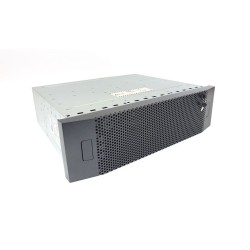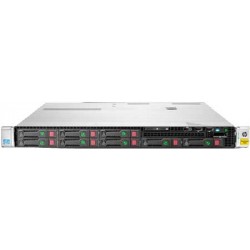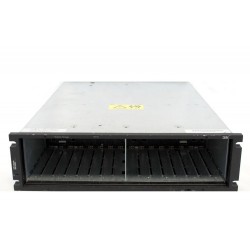Buy Refurbished & Second Hand Disk Storage Array Online
What is Disk Storage Array
A disk storage array, also known as a storage array or disk array, is a centralized data storage system that uses multiple disk drives to store and manage data. A disk storage array typically consists of one or more enclosures that house the disk drives, as well as a controller that manages the data stored on the disks.
Disk storage arrays are designed to provide high performance, scalability, and reliability. They are commonly used in enterprise environments where large amounts of data need to be stored and accessed quickly and efficiently.
Disk storage arrays can be classified into different types based on the technology used, such as Direct Attached Storage (DAS), Network Attached Storage (NAS), and Storage Area Network (SAN). DAS connects the storage array directly to a server, while NAS and SAN provide network connectivity and allow multiple servers to access the storage array simultaneously.
Disk storage arrays can also be classified based on the type of disk drives used, such as Solid-State Drives (SSDs) or Hard Disk Drives (HDDs). SSDs provide faster access times and higher performance, while HDDs offer higher capacity at a lower cost. Many disk storage arrays use a combination of both SSDs and HDDs to provide a balance between performance and capacity.
Best Disk Storage Array Solutions
There are several disk storage array solutions available in the market.
Dell EMC Unity XT:
This solution is designed to deliver unified storage with an affordable and flexible architecture. It offers high performance and scalability for midrange workloads and provides features such as data reduction, automated tiering, and data protection.
NetApp AFF:
NetApp AFF is a hybrid flash storage solution that offers enterprise-level performance, scale, and availability. It provides features such as inline data reduction, data tiering, and encryption, which help optimize storage performance and efficiency.
HPE Nimble Storage:
HPE Nimble Storage is an adaptive flash array solution that provides high performance, efficiency, and reliability. It offers features such as predictive analytics, advanced data protection, and cloud integration.
Pure Storage FlashArray:
Pure Storage FlashArray is a fully integrated and scalable storage solution that offers high performance and efficiency. It provides features such as deduplication, compression, and encryption, which help reduce storage costs and increase security.
IBM DS8880:
IBM DS8880 is a high-end disk storage solution that offers enterprise-level performance, reliability, and scalability. It provides features such as encryption, compression, and automated tiering, which help optimize storage performance and efficiency.
Ultimately, the best disk storage array solution depends on your specific needs and requirements. Consider factors such as capacity, performance, scalability, data protection, and cost when selecting a solution.
List Disk Storage Array Configuration
| Name | State | Description | Size |
| hdisk8 | Optimal | RAID 6 Array | 69.6GB |
| pdisk0 | Active | Array Member | 34.8GB |
| pdisk2 | Active | Array Member | 34.8GB |
| pdisk8 | Active | Array Member | 34.8GB |
| pdisk9 | Active | Array Member | 34.8GB |
| hdisk7 | Optimal | RAID 0 Array | 34.8GB |
| hdisk13 | Optimal | RAID 0 Array | 34.8GB |
| hdisk0 | Available | SAS Disk Drive | 146.8GB |
| hdisk1 | Available | SAS Disk Drive | 146.8GB |
Disk Storage Array Technologies
There are several disk storage array technologies used in the market today
Flash Storage:
Flash storage technology uses solid-state drives (SSDs) to store and manage data. SSDs offer faster access times and higher performance than traditional hard disk drives (HDDs). Flash storage arrays are commonly used in high-performance computing environments where low latency and high throughput are required.
Cloud Storage:
Cloud storage arrays use a network of remote servers to store and manage data. Cloud storage arrays can be public or private and offer several advantages such as scalability, flexibility, and accessibility from anywhere.
Object Storage:
Object storage is a technology that stores data as objects rather than files or blocks. Object storage arrays are designed to store large amounts of unstructured data, such as media files or documents, and provide features such as scalability, data protection, and data retention.
Software-Defined Storage:
Software-defined storage (SDS) is a storage architecture that separates the storage hardware from the software that manages it. SDS allows for greater flexibility and scalability, as well as the ability to use different types of storage devices and technologies in the same storage array.
Hybrid Storage:
Hybrid storage arrays combine different types of storage technologies, such as HDDs and SSDs, to provide a balance between performance and capacity. Hybrid storage arrays can automatically move frequently accessed data to the faster SSDs, while less frequently accessed data is stored on the HDDs.
The choice of disk storage array technology depends on the specific needs and requirements of the organization. Factors such as performance, capacity, cost, scalability, and data protection should be considered when selecting a disk storage array technology.
How to Improve Disk Storage Array Performance
Here are some ways to improve the performance of a disk storage array:
Use Solid-State Drives (SSDs):
Solid-state drives (SSDs) are faster and have lower access times compared to traditional hard disk drives (HDDs). Consider using SSDs to improve the performance of the disk storage array.
Use RAID Technology:
RAID technology provides redundancy and can improve the performance of the disk storage array. RAID 0 and RAID 5 are commonly used to improve performance.
Upgrade the Network:
The network used to connect the disk storage array to the servers can impact the performance. Consider upgrading to faster networking technologies such as 10 Gigabit Ethernet or Fiber Channel.
Optimize the File System:
The file system used on the disk storage array can impact the performance. Consider optimizing the file system by using a more efficient file system or by tuning the existing file system.
Use Caching:
Caching can improve the performance of the disk storage array by storing frequently accessed data in memory. This can reduce the number of disk accesses required and improve overall performance.
Use Tiered Storage:
Tiered storage can improve performance by using different types of storage media, such as SSDs and HDDs, in the same storage array. Frequently accessed data can be stored on the faster SSDs, while less frequently accessed data can be stored on the slower HDDs.
Monitor and Optimize Workloads:
Monitoring and optimizing workloads can help identify performance bottlenecks and optimize the disk storage array for specific workloads. This can involve tuning settings such as block size, queue depth, and read/write ratios.
By implementing these strategies, you can improve the performance of your disk storage array and ensure that it meets the needs of your organization.
Conclusion
In conclusion, a disk storage array is a centralized data storage system that uses multiple disk drives to store and manage data. There are several disk storage array technologies available, including RAID, flash storage, cloud storage, object storage, software-defined storage, and hybrid storage.
To improve the performance of a disk storage array, consider using solid-state drives (SSDs), RAID technology, upgrading the network, optimizing the file system, using caching, using tiered storage, and monitoring and optimizing workloads. By implementing these strategies, you can improve the performance of your disk storage array and ensure that it meets the needs of your organization.
A storage array disk is a physical disk drive used in a disk storage array. Multiple storage array disks are typically combined to create a centralized storage system for storing and managing data. These disks may use different technologies such as hard disk drives (HDDs) or solid-state drives (SSDs) and may be organized in various configurations, such as RAID, to provide performance and redundancy benefits.
The function of a disk array is to provide centralized storage for storing and managing data. Disk arrays combine multiple disk drives into a single logical unit, allowing for increased performance, capacity, and data redundancy. They also typically include features such as data protection, data management, and scalability, making them an essential component of enterprise storage infrastructure.
Disk storage is used for storing and managing digital data, including files, documents, media, and applications. Disk storage is commonly used in enterprise data centers, cloud storage environments, and personal computing devices such as laptops and desktops. It allows for data to be stored and accessed efficiently, securely, and reliably over an extended period.












